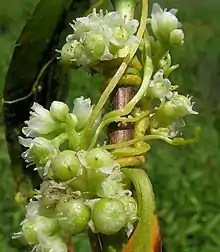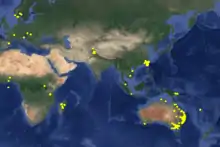| Australian dodder | |
|---|---|
 | |
| Scientific classification | |
| Kingdom: | Plantae |
| Clade: | Tracheophytes |
| Clade: | Angiosperms |
| Clade: | Eudicots |
| Clade: | Asterids |
| Order: | Solanales |
| Family: | Convolvulaceae |
| Genus: | Cuscuta |
| Species: | C. australis |
| Binomial name | |
| Cuscuta australis | |
 | |
| Occurrence data from GBIF[3] | |
| Synonyms[4] | |
|
Cuscuta obtusiflora var. australis (R.Br.) Engelm. | |
Cuscuta australis, commonly known as Australian dodder, is a herb in the family Convolvulaceae.[1]
The annual parasitic twining herb or climber that is associated with many hosts. It blooms between November and March producing 5-merous[5] white-cream-yellow flowers[1] in compact clusters on pedicels which are less than 2.5 millimetres (0.1 in) long.[5] The lobes are rounded-triangular and shorter than or equal in length to the corolla tube.[5] It parasitises both native and exotic plants.[5] To maximize its seed yield, it synchronizes its flowering to that of its host plant via detection of a signaling protein in the host.[6]
Distribution
Australia
In Western Australia, it is found in a small area in the Fitzgerald River National Park in the Great Southern and Goldfields-Esperance regions of Western Australia where it grows in sandy-clay soils.[1] It is also found in New South Wales, Victoria, Queensland,[5] and New Guinea[7]
Elsewhere
It is found widely throughout the world and considered native to Europe, tropical Asia, Africa, Australasia and temperate Asia.[4]
Taxonomy
C. australis was first described by Robert Brown in 1810.[2][1] The type specimen, BM00016305,[8] was collected on 25 September 1802 at Broad Sound, Queensland, Australia by Robert Brown.
References
- 1 2 3 4 5 "Cuscuta australis". FloraBase. Western Australian Government Department of Biodiversity, Conservation and Attractions.
- 1 2 Brown, R. 1810. Prodromus florae Novae Hollandiae 491
- ↑ GBIF.org (26 June 2018) GBIF Occurrence Download https://doi.org/10.15468/dl.gqc46w Cuscuta australis R.Br.
- 1 2 Govaerts, R.; et al. "Cuscuta australis". Plants of the world online. Board of Trustees of the Royal Botanic Gardens, Kew. Retrieved 26 June 2018.
- 1 2 3 4 5 Johnson, R.W. (1992). "Cuscuta australis". Plant NET New South Wales Flora online. National Herbarium of NSW, Royal Botanic Gardens, Sydney. Retrieved 26 June 2018.
- ↑ Shen, G., Liu, N., Zhang, J., Xu, Y., Baldwin, I. T., Wu, J. (2020-08-31). "Cuscuta australis (dodder) parasite eavesdrops on the host plants' FT signals to flower". Proceedings of the National Academy of Sciences. 117 (37): 23125–23130. Bibcode:2020PNAS..11723125S. doi:10.1073/pnas.2009445117. PMC 7502711. PMID 32868415. S2CID 221404792.
{{cite journal}}: CS1 maint: multiple names: authors list (link) - ↑ AVH: Cuscuta australis occurrence data (Distribution map) Australasian Virtual Herbarium. Retrieved 26 June 2018
- ↑ "Type of Cuscuta australis R.Br". Global Plants. Retrieved 26 June 2018.